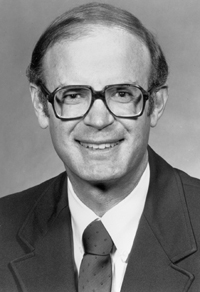In Memoriam: James E. Watson, Jr.
1938-2009
by Paul S. Stansbury, CHP, and Daniel J. Strom, CHP

James E. Watson, Jr., “Jim” to his friends and professional colleagues and “Dr. Watson” to his many students, died 2 April 2009 at his home in Chapel Hill, North Carolina. His colleagues will remember his quiet charisma, soft spoken with a cadence often found in those raised in the South, smiling often, with a sincere appreciation of those around him. Although quiet and unassuming, Jim was organized. He had a plan, whether it was for his distinguished research career studying radon or whether it was for his professional activities, such as serving as president of the Health Physics Society in 1985 to 1986. To his students, he was a mentor and a coach, coaxing the most out of each one. Many remember his bold, clear penmanship suggesting revision of their work, always offering constructive criticism and a path forward to remedy a shortcoming. Jim’s expression of even a hint of disappointment in a student’s work elicited a sincere effort on the part of the student to make it right.
Broadly speaking, there are three approaches taken to the teaching of radiation protection in the United States: the radiological physics approach, the radiological engineering approach, and the public health approach. Jim Watson embodied the latter, that is, the approach of disease prevention and health promotion, emphasizing not only health physics but embracing biostatistics and epidemiology
Promoted to director of the Radiological Hygiene Program in the School of Public Health at the University of North Carolina at Chapel Hill (UNC) in the late 1970s, he developed and implemented an innovative curriculum for those preparing for a career in radiation protection. Besides solid academic preparations, he emphasized the importance of the practical side of health physics. He led his students on a week-long field trip of nuclear facilities in the Southeast, of which there are many different types. He enabled many of his students to undertake a summer practicum, working for a practicing health physicist or working for someone doing health physics research. His students have had successful careers, many rising to leadership positions in government, industry, or academia.
Jim earned a BS in nuclear engineering and an MS in physics from North Carolina State University and a PhD in environmental sciences and engineering from UNC. After his studies, he had a full and productive professional career. He served on the UNC faculty for 27 years, where he received various awards for excellence in teaching from the Underwood and McGavran Awards to an award from the Greenberg Alumni Endowment Award for excellence in teaching, research, and service. He served as president of the Radiological Health Section of the American Public Health Association.
In addition, Jim chaired the Radiation Advisory Committee of the Environmental Protection Agency’s Science Advisory Board and served on National Academy of Sciences committees studying radioactive waste management.
He served as an expert in radiological “dose assessment” (now called “dose reconstruction”) for the U.S. Department of Energy health and mortality studies until their transfer to the National Institute for Occupational Safety and Health.
He was appointed by two of North Carolina’s governors to the North Carolina Radiation Protection Commission, on which he served a total of 24 years. He is the recipient of the North Carolina’s Order of the Long Leaf Pine, the highest honor awarded by the state of North Carolina to one of its citizens.
Despite his busy life as a professor, researcher, and leader in his profession, he found the time for a hobby often typical of a southern gentleman, duck hunting.
Jim is survived by his wife, Dr. Betty Revsin-Watson; his mother, Louise Watson; and his two brothers and their wives. He will be missed and fondly remembered by his former students and professional colleagues.




